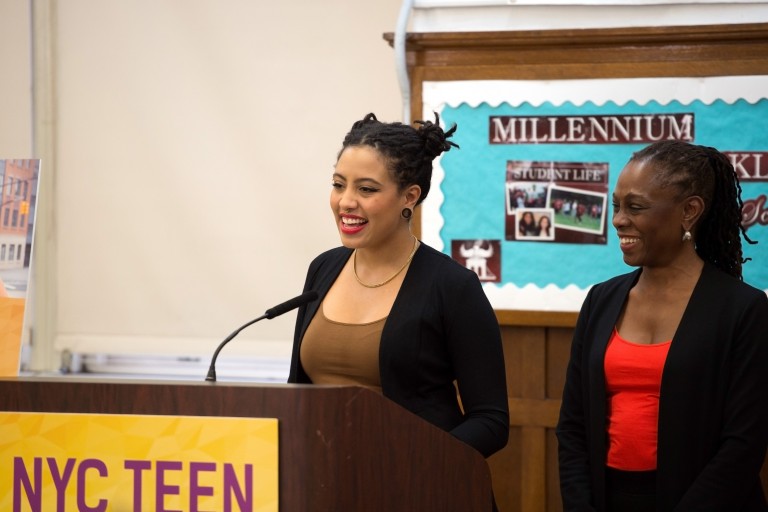Photo: Chiara de Blasio (at podium) and her mom, First Lady Chirlane McCray, speak at an NYC Teen Text event. Courtesy of Demetrius Freeman/Mayoral Photography Office.
It seems that mental healthcare has always been a difficult issue for the city to navigate, from the early days of poorly staffed and run asylums, to patient abuse, neglect and inadequate funding.
But the de Blasio administration, through First Lady Chirlane McCray, has made mental health services a priority, through addressing such topics as stigma, and by pushing to make such care available to all residents.
McCray has also been working to help make significant changes in the way the city handles mental health care within the criminal justice system. Last year, Mayor Bill de Blasio announced a new $130 million program aimed at reforming the way the city handles mentally ill inmates by reducing unnecessary arrests and incarceration, while tackling the behavioral health concerns of prisoners.
In a February op-ed in the New York Daily News that was spurred by her search for a mental health professional for her daughter, Chiara de Blasio, McCray wrote that our “mental health system is broken” and that we are facing a “national mental health crisis.”
“The first step to solving the crisis is to simply acknowledge that it exists,” McCray wrote. “We must start a real public conversation about mental illness, and we must start connecting people to appropriate services. That is how we will shatter the stigma.”
She noted that 25 percent of American deals with mental illness in any given year, and that 61 percent of adults and 35 percent of children in New York who need mental health services don’t get them.
In the op-ed, McCray promised that in the next few months, she would travel the city borough-by-borough, to meet with residents and hear their mental health stories that will ultimately help to inform municipal policy by way of the Mayor’s Fund to Advance NYC, the Department of Mental Health and Hygiene, and the Fund for Public Health, all with the goal of creating a “roadmap for a more inclusive mental health system.”
Also in February, McCray spoke at the Vera Institute of Justice, examining the “nexus of poverty, mental health and the criminal justice system.” She shared her vision for a “more enlightened” approach to delivering mental health services—one that features “caregivers who understand the language and culture of the people they serve.”
Most recently, McCray and Chiara helped launch a mental health texting pilot program at 10 public schools.
The program will enable teens at participating schools to text “NYC Teen” to 65173 to receive prompt, confidential information and emotional support on issues running the gamut from feeling sad and hopeless, to anxiety. Participating schools in Queens include Townsend Harris High School and Robert F. Kennedy Community High School, both in Flushing, and the Frank Sinatra School of the Arts in Astoria.
City health officials report that many teens experience emotional stress, yet few seek or receive help.
“Our goal is to meet teens where they are—and where they are is on their phones,” McCray said.
Commenting on the Daily News op-ed, online poster and mental health worker Bridgett Gee applauded McCray’s efforts and agreed that the mental health system is in need of repair.
“I worked in an MH inner city clinic where we turned away patients left and right due to too many patients…The need overrode the ability of the clinic to safely treat these patients,” Gee wrote. “A lot of people are walking around untreated from minor anxiety to full blown schizophrenia due to lack of facilities and personnel.”
By Alan Krawitz alan.krawitz1@gmail.com

